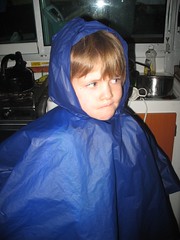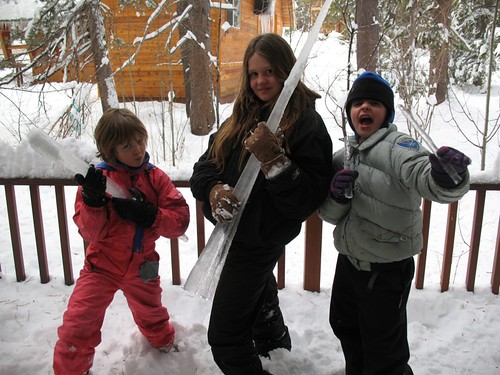I have learned so much more respect for our pioneer ancestors. It always seemed so implausible to me that you could arrive in the Pacific Northwest and literally freeze to death in the winter. After all, it never freezes here. So how is it done? Well, let me tell you.
One very creative way to freeze to death in the Pacific Northwest in the winter is to move on to a friggin’ sailboat in the middle of winter and bob around in 40-degree water with the wind whipping by at 40 knots. Let us compound the problem by killing the heater. Twice. Since the “fix” costs $300, after the second breakdown we pretty much had to make a decision between freezing and eating.
We chose to freeze.
What I learned this winter is how you can completely and utterly do without traditional heat sources.
Back in the good old days when we were rich and normal, we had a house with central heat. The furnace would kick on in mid-October and grind away until mid-May. We felt oh so self-righteous when we took the Global Challenge and turned our thermostat down to 68 Fahrenheit. It was chilly enough that people remarked on it when they visited the house. But on the whole, 65 to 68 was quite pleasant as long as you wore a sweater – or as is more common in Seattle, a fleece pullover. We would snuggle beneath an Ikea throw on the couch, watching our movies, sipping red wine (box, of course) and munching on microwave popcorn, replete and smug in the knowledge that our thermostatic sacrifice was helping to ensure a future for our children.
Let's contrast this to our current state. When we stepped onto the boat this evening, the gauge read 44 degrees. Through the creative use of halogen lights, a kerosene lantern and baking cookies, we've raised the temperature in the salon to a balmy 59.
Unfortunately, heat rises. This ensures that any heat we generate making dinner and eating it in the light of our own personal sun lamp does not make it down into the cabins. As I type in the master cabin, my breath is frosting and floating to the ceiling to condense on the hatch cover and slide down the walls. The principle source of heat in here is the adapter for my laptop charger. Never have I more appreciated the fact that Apple chargers are roughly hot enough to fry eggs. We're using it as a bed warmer to ward off frostbite.
Yet, we are not actually all that uncomfortable. I think, in fact, that were it not for all the condensation, I could actually live this way pretty much indefinitely. I can assure you unequivocally that our future land-based house will never have a winter temperature setting higher than 60. There are tricks to living in the cold that you learn quickly or run away from this life screaming.
Pretend Like It's Warm – There are lots of ways to make your boat look warm even when it is not. Believe it or not, our mammalian brains are truly stupid enough to buy this nonsense. If you fill the boat with a warm glowing ambiance, your dumb ass brain registers the color and flicker as a radiant camp fire and makes you believe it's warmer than the thermostat actually reads. It helps, by the way, to turn the thermostat around so that you can't see it. Again, the human brain is surprisingly stupid. If you don't know it's 44 degrees, maybe it's 50.
Think positive.
To create that warm radiant glow, I recommend BeanPod candles. Get one with a nice campfire sounding name like Cedar Chest or Evergreen. Put one of these beauties in the center of the table. Then surround yourself in cheap tea candles from Ikea. Put them absolutely everywhere. They do not generate heat. You just think they do.
Cook – Normally, I find cooking on the boat a bit of a chore. There are only two burners, virtually no counter space, and the oven has two temperatures now that Dr C has ditzed with it: off and nuclear. However, cooking generates two absolutely critical byproducts: heat and odor. Your boat is not a very big place, and simmering soup or chili for half an hour, boiling a pot of tea, or baking a lasagna can actually heat the boat all by itself. Also, the aromas of roasting meat, sautéing onions and garlic, and baking chocolate chip cookies do wonders for encouraging the hind brain to think warm and happy thoughts.
Kerosene Lanterns – These are absolutely great on a boat. A kerosene lantern produces a truly astonishing amount of light. It’s also hot. HOT. Our lantern can take the salon from 45 to 55 in 20 minutes. I recommend purchasing these from the Amish catalog. Believe it or not, despite their complete repudiation of electricity, the Amish are served by a fine web site. Okay, this seems totally oxymoronic, but I recognize now that this site must do a really good side business in idiots like us.
Halogen Lights – Ironically, everyone on my catamaran list is yackity yacking about how to swap out all these halogen bulbs in all the fixtures on the boat with more efficient LED. The halogens are the second largest consumer of electricity on the Lagoon catamarans. Swapping them for the more parsimonious LED’s makes for more light at considerably less electrical cost. If you live someplace cold, however, don't do it. The halogens easily increase the temperature of the cabins by five degrees.
Ultimately, what it takes to live on a cold boat is the willingness to be cold. It's really that simple. If you stop taking heat for granted and treat it for the incredible and expensive resource it truly is, you will find the nights endurable and the days at the office pure pleasure.
One very creative way to freeze to death in the Pacific Northwest in the winter is to move on to a friggin’ sailboat in the middle of winter and bob around in 40-degree water with the wind whipping by at 40 knots. Let us compound the problem by killing the heater. Twice. Since the “fix” costs $300, after the second breakdown we pretty much had to make a decision between freezing and eating.
We chose to freeze.
What I learned this winter is how you can completely and utterly do without traditional heat sources.
Back in the good old days when we were rich and normal, we had a house with central heat. The furnace would kick on in mid-October and grind away until mid-May. We felt oh so self-righteous when we took the Global Challenge and turned our thermostat down to 68 Fahrenheit. It was chilly enough that people remarked on it when they visited the house. But on the whole, 65 to 68 was quite pleasant as long as you wore a sweater – or as is more common in Seattle, a fleece pullover. We would snuggle beneath an Ikea throw on the couch, watching our movies, sipping red wine (box, of course) and munching on microwave popcorn, replete and smug in the knowledge that our thermostatic sacrifice was helping to ensure a future for our children.
Let's contrast this to our current state. When we stepped onto the boat this evening, the gauge read 44 degrees. Through the creative use of halogen lights, a kerosene lantern and baking cookies, we've raised the temperature in the salon to a balmy 59.
Unfortunately, heat rises. This ensures that any heat we generate making dinner and eating it in the light of our own personal sun lamp does not make it down into the cabins. As I type in the master cabin, my breath is frosting and floating to the ceiling to condense on the hatch cover and slide down the walls. The principle source of heat in here is the adapter for my laptop charger. Never have I more appreciated the fact that Apple chargers are roughly hot enough to fry eggs. We're using it as a bed warmer to ward off frostbite.
Yet, we are not actually all that uncomfortable. I think, in fact, that were it not for all the condensation, I could actually live this way pretty much indefinitely. I can assure you unequivocally that our future land-based house will never have a winter temperature setting higher than 60. There are tricks to living in the cold that you learn quickly or run away from this life screaming.
Pretend Like It's Warm – There are lots of ways to make your boat look warm even when it is not. Believe it or not, our mammalian brains are truly stupid enough to buy this nonsense. If you fill the boat with a warm glowing ambiance, your dumb ass brain registers the color and flicker as a radiant camp fire and makes you believe it's warmer than the thermostat actually reads. It helps, by the way, to turn the thermostat around so that you can't see it. Again, the human brain is surprisingly stupid. If you don't know it's 44 degrees, maybe it's 50.
Think positive.
To create that warm radiant glow, I recommend BeanPod candles. Get one with a nice campfire sounding name like Cedar Chest or Evergreen. Put one of these beauties in the center of the table. Then surround yourself in cheap tea candles from Ikea. Put them absolutely everywhere. They do not generate heat. You just think they do.
Cook – Normally, I find cooking on the boat a bit of a chore. There are only two burners, virtually no counter space, and the oven has two temperatures now that Dr C has ditzed with it: off and nuclear. However, cooking generates two absolutely critical byproducts: heat and odor. Your boat is not a very big place, and simmering soup or chili for half an hour, boiling a pot of tea, or baking a lasagna can actually heat the boat all by itself. Also, the aromas of roasting meat, sautéing onions and garlic, and baking chocolate chip cookies do wonders for encouraging the hind brain to think warm and happy thoughts.
Kerosene Lanterns – These are absolutely great on a boat. A kerosene lantern produces a truly astonishing amount of light. It’s also hot. HOT. Our lantern can take the salon from 45 to 55 in 20 minutes. I recommend purchasing these from the Amish catalog. Believe it or not, despite their complete repudiation of electricity, the Amish are served by a fine web site. Okay, this seems totally oxymoronic, but I recognize now that this site must do a really good side business in idiots like us.
Halogen Lights – Ironically, everyone on my catamaran list is yackity yacking about how to swap out all these halogen bulbs in all the fixtures on the boat with more efficient LED. The halogens are the second largest consumer of electricity on the Lagoon catamarans. Swapping them for the more parsimonious LED’s makes for more light at considerably less electrical cost. If you live someplace cold, however, don't do it. The halogens easily increase the temperature of the cabins by five degrees.
Ultimately, what it takes to live on a cold boat is the willingness to be cold. It's really that simple. If you stop taking heat for granted and treat it for the incredible and expensive resource it truly is, you will find the nights endurable and the days at the office pure pleasure.

